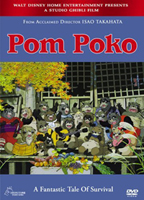 BUY IT AT AMAZON: CLICK HERE!
BUY IT AT AMAZON: CLICK HERE!
STUDIO: Walk Disney Home Entertainment
MSRP: $29.99
RATED: PG
RUNNING TIME: 119 minutes
SPECIAL FEATURES:
• Trailers
• TV spots
• Animated storyboards
Studio
Ghibli has a history of putting pro-environmental messages into their films,
covertly and overtly. Such a message was the entire plot of the fanciful Nausicaa
of the Valley of the Wind, and the fight between technology and nature
was more than metaphor in Princess Mononoke. Neither of those
occur in the real world, but even Spirited Away (which, arguably,
does) drew in a bit of that tension on one of its many sub-threads. Pom
Poko does similar to the latter, in casting real-world humans as the
villains in the struggle, but, like Nausicaa, makes the fight to
maintain nature the center of its narrative.
That’s a
lot of
Takahata, the man who also gave us the film that most geeks are proud to admit
made them cry: Grave of the Fireflies. Initially, Pom Poko might strike a
viewer as immature, childish (not child-like), a bit of woodland propaganda. Watership
Down with less prophecy. I encourage those viewers to stick with the
nearly two-hour film; amongst the playfulness, there is a realism that dogs the
events, and brings the conclusion to a somber, thoughtful resolution.

Three seconds had to be cut from this scene to make the PG rating.
The Flick
It is the
year thirty-one in the Pom Poko calendar. (Why does that
matter? Because the story spans a couple of years, which puts the ending right
around year thirty-three.) In the Tama hills near
are finding that their forest is shrinking. They put aside their squabbles for
food and territory to investigate the cause, and discover that the humans are
encroaching on their land, building brand-new housing developments to satisfy
the demand in
The
raccoons refuse to let their beloved land be destroyed, turned to muddy banks
and asphalt, so they resolve to do something about it. That something, as it
turns out, is to reclaim their magical powers of transformation, train the
young ones in how to infiltrate human society, and torment the construction
workers whose hands are causing the symptoms the raccoons fear. Up until this
point, the narrative feels realistic (except for the talking raccoons, and the
contextual animation styles, which I’ll talk about later), but here Takahata
starts to steer us in the direction that he’s aiming. Pom Poko becomes a modern
myth, an extension of the animistic Japanese folk tales about clever foxes and
lazy raccoons. This becomes a surprisingly effective way of communicating the
story, deftly bridging the past and present.

Oh, Charlie X, you lovable cad.
The
animation style serves to support the myth-based narrative, though it’s not
obvious how until the above plot point. Rather than drawing the raccoon
characters as though they are real, as though the artists are merely glancing
through a window into another world and faithfully recreating what they see,
there are different animation styles applied to the characters depending on the
context. There are broad, minimal strokes for the raccoons when they are at the
extremes of their emotion, either happy or sad; there are slightly more
detailed, but still Care Bear-esque raccoons when they are acting out their plots
against humanity; and there are detailed, four-legged, realistic raccoons when
they are acting as raccoons in our world do. It’s not a new direction in
Japanese art, as it gets used extensively in plenty of modern manga and anime
(and to the point of brain-death in FLCL), but it is employed with
direction, here, and supports the narrative well.
Another
factor that contributes to the mythic quality of the film is the way the
narrative is expressed. It’s not given over to the characters to drive the plot
forward, but instead an omniscient narrator (voiced by Maurice LaMarche, Brain
on "Pinky and the Brain") who maintains a presence through the entire
running time. The individual characters are reduced to ciphers, and it is given
to the narrator to set up each vignette as it relates to the whole. Usually,
this is a no-no in film, but here it only works to reinforce the texture
Takahata was going for. Pom Poko ends up feeling like a bedtime
story, a fairy tale. You don’t get attached to the characters in fairy tales;
you remember the situations. You don’t know
Cinderella; you remember that the klutz tripped on a carpet and hobbled home.
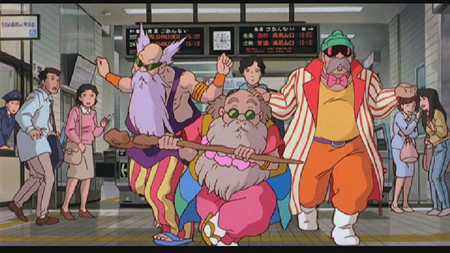
Masters of Transformation, yes. Masters of Social Interaction, no.
The
second act of the film is devoted to the raccoons’ attempts to frighten the
humans away, and it’s right around here the film earns its PG rating. (There’s
also the issue of magical raccoon nutsacks to address, but, well, I’d rather
not.) The raccoons kill humans. They terrify them with visions of melting
faces. They stage an elaborate parade through the burgeoning development that
is simultaneously more memorable and more disturbing than the "Pink
Elephants" sequence in Dumbo. Young children exposed to
this stuff would have glorious, amusing nightmares.
As the
story progresses, it becomes more and more complex. The raccoons who are able
to transform themselves into the likenesses of humans find that they enjoy
human society quite a bit, especially the food. They don’t want to push back
the humans completely, just out of their neck of the woods. A faction of
raccoons emerges who wants to destroy as many humans as possible, staging
guerilla attacks without the consent of the great raccoon council. Gradually,
the raccoons lose control of their focus and they fight a climactic, small, and
representative battle with the humans, setting up the bittersweet denouement.
Except
for a grating piece of direct proselytizing, the ending is handled with a lot
of subtlety. The raccoons, as a race, learn a lesson or two, and the whole
thing seems almost to come out in favor of humans, encouraging large housing
developments whenever possible. The tone of the ending contradicts that surface
reading, however, and adds a note of complexity to both side of the argument.
expansion are more clean-cut — pollution equals bad, nature equals good — but
Takahata brings out a bit of the anticlosure that made Grave of the Fireflies
such a success, and works it around, to a lesser degree, here.
The
running-time is a bit excessive for a story so simple — and it is a simple
story, despite the branching paths the characters follow while trying to
achieve the same goal. Myths don’t need to be overly complex, just memorable
and thought-provoking. Despite (or maybe because of) the disturbing imagery,
this is the sort of thing I would like to show my children. Gotta make the
little buggers think.
7.5 out of 10
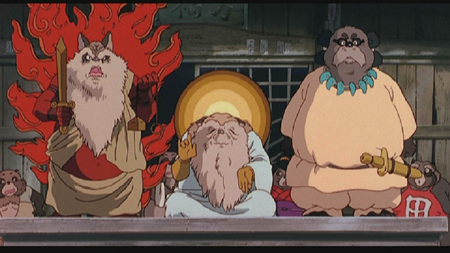
Hades, Buddha, and… Gus?
The Look
Widescreen,
1.85:1. I have absolutely no complaints with the way this film looks on DVD. These
Disney releases of Ghibli films have been top-notch all the way across the
board. The animation is typically beautiful, the three distinct character
styles all presented in perfect context. The landscapes have that vibrant,
familiar unreality that is typical of Ghibli films. The colors came across
perfectly, and the transfer is flawless.
9 out of 10
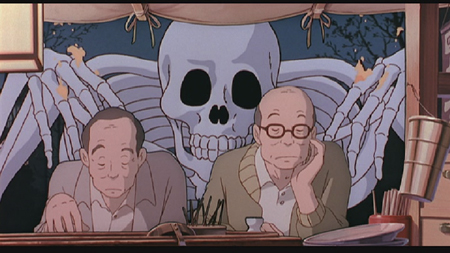
"Say, could I have a sake and a mop?"
The Noise
Dolby 2.0
Surround. The original Japanese language track is a joy, and the subtitles that
accompany it preserve more of the linguistic playfulness than does the English
dub. The dub is top-notch, though, with fewer of the hammered-in awkward
phrasings that interfered with Spirited Away.
The music
is beautiful, but hidden too low in the mix to be memorable unless you’re
digging for it. It would have fared much better in 5.1, I’m sure. Still,
there’s a good variety of instrumentation used to punctuate the major plot
points, and the tone is folksy where appropriate and fully orchestral on the
big dramatic cues.
7 out of 10
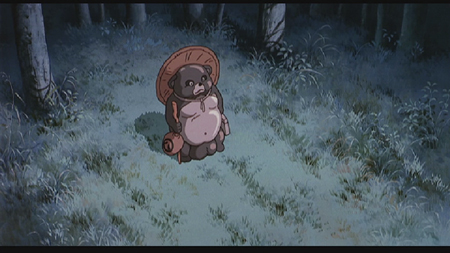
Authorial intrusion: I’m sorry, I– just– raccoon nutsack.
The Goodies
There’s
an extra disc of bonus features, but it’s kind of deceptively labeled, because
in actuality it is a disc of bonus feature.
The second disc consists entirely of a non-interactive set of original
storyboards. They’re interesting, sure, but they really ought to have provided
a menu to select which sequence you’d like to see storyboarded, rather than
presenting them in a lump.
The other
disc has trailers and TV spots. All together, it’s kind of disappointing for a
two disc set.
5 out of 10

101st Flying Nutsacks, away!
The Artwork
Taking a
glance at the front cover will give you an idea of how many different
characters the narrator has to keep tabs on. It’s positively Homeric. It also
gives a potential viewer the chance to see if they’ll be able to stand the
unabashedly cute mode of animation.
I’m not a
big fan of the stripes of color segmenting off the cover into title, picture,
blurb sections. It makes the thing look like a textbook.
5 out of 10
Overall: 7 out of 10